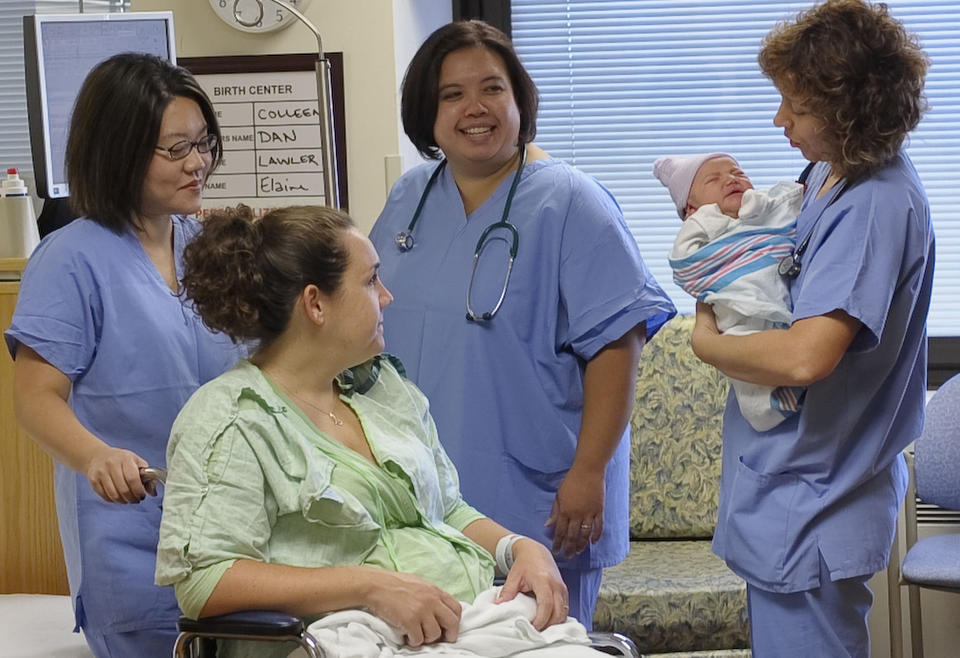Blogrige
The Official Baldrige Blog

Photo used with permission of Advocate Good Samaritan Hospital
A perfect storm is churning through the health care industry, which has seen declining reimbursement, increased public reporting of performance data, and increased media coverage on preventable patient safety issues. In order to be successful, a health care organization needs to ensure a culture of patient safety by avoiding such errors and other catastrophes. But how do you create that culture?
I asked experts from the Advocate Health Care system in Illinois, who are speaking at the Baldrige regional conference in Chicago on September 8, to offer some tips on what health care organizations can do to meet this perfect storm and for insight on the takeaways they will be sharing at their conference presentations.
Presenters Chuck Derus, vice president of medical management, and Mary Schleinzer, director of patient safety, from Baldrige Award recipient Advocate Good Samaritan Hospital, will be presenting “Creating a Culture of Safety: Leading to High Reliability.” According to Patricia A. Skriba, vice president, business excellence, at Advocate Good Samaritan Hospital, “Over 440,000 lives, about the population of Miami, are lost each year due to preventable medical errors, making medical errors the third leading cause of death in the United States. Safety is about high reliability, which is avoiding catastrophes in high-risk, high-complexity environments—health care is one of those environments. . . . All venues of health care—from the hospital to the physician office, to the pharmacy to the outpatient clinic, to home health care—are rich in opportunities for transformation.”
Pamela Hyziak, director, performance excellence, at Advocate Lutheran General Hospital, a Baldrige-based ILPEx state gold award recipient, added, “There has been a shift in recent years that has heightened the importance of a culture of safety, due to changes both inside and outside the industry that have necessitated this change to high reliability.” Hyziak and her colleague Katie Bata, vice president of human resources, will be presenting “Creating a Successful Organization Now and in the Future” at the Chicago conference.
The health care expert presenters believe that the Baldrige Excellence Framework can support organizations in their high-reliability efforts and in sustaining a culture of safety.
“The Baldrige framework has been effective in supporting our organization’s efforts to achieve high reliability,” said Hyziak. “High reliability involves the application of the Baldrige Approach, Deployment, Learning, and Integration methodology (ADLI) to criteria from the six Baldrige process categories. [At Advocate Lutheran General Hospital,] senior leaders create an environment for high reliability and also develop and deploy strategies to reduce harm. In addition to associates and physicians in high-reliability work, patients and communities are engaged as advisory team members. New measures have been developed to measure harm, allowing [performance improvement] teams to generate new knowledge, which drives process improvements and innovations for improved outcomes.”
Skriba and Hyziak offer tips that will be further illuminated at their conference sessions. Skriba offers these tips:
- Ensure that senior leaders, who have responsibility for the creation and promotion of a culture of safety, define and deploy the “vision” and goal for safety in their organization.
- Measure and track harm, getting a baseline of not only serious safety events where patients are harmed but also those “pre-cursor” events that were errors but did not seriously harm or reach the patient. Make harm visible.
- Create a mechanism that creates a “sensitivity to operations” and allows the safety issues or potential safety issues to surface from the frontline. Our daily patient safety huddle led by the hospital president is one of those mechanisms for us. It allows us to “look back” over the previous 24 hours and take a “look ahead” to fix and prevent safety events.
- Develop leaders in their understanding of the “science of safety.” Identify communication behaviors and tools that will dramatically reduce error, and train, model, and audit the workforce in these tools. For example, use STAR—stop, think, act, review—when doing a task that is critical to do RIGHT the first time. Aviation has learned many of these techniques that are proven to reduce harm by 90%.
- Design, redesign, and improve processes to ensure safety, as many safety errors are process related.
Added Hyziak,
- Systematically reward and recognize patient safety event reporting. You can’t reduce harm if you don’t know that the harm exists. Continually evaluate and improve your reward and recognition approaches to ensure that they are effective.
- Strive for a just culture, which eliminates fear and supports a culture of open communication and learning.
- Maintain a strong focus on action that includes causal analysis and measurements to ensure the effectiveness of action plans.
- Communicate, communicate, and communicate, individually and to groups, explaining the rationale for change. Daily communication, such as a huddle, is very effective and supports the culture for transparency.
- Ensure process audits and key in-process measures, with real-time feedback to associates, because they strengthen accountability and help to hard-wire best practices.
“The health care industry is going through unrelenting change. Sustained excellence in that type of environment can only be achieved through systematic, integrated approaches,” said Skriba. “The Baldrige framework is a balanced business model that provides health care organizations the potential of high reliability in all aspects of their business.”
She added, “Baldrige should be how we do our work—not something in addition to our work. Organizations have a choice: conduct their business and work through systematic approaches that connect to what’s important, or be more person-dependent [and less reliable] in that same work.” Which choice would you like your health care organization to choose?
Note: Pamela Hyziak and Patricia Skriba will be speaking at the Baldrige regional conference in Chicago on September 8—along with many other representatives of Baldrige Award recipients in Chicago and Dallas (on September 22). You can access the full schedules and register from links on our website.
About the author
Related Posts
Comments
- Reply





